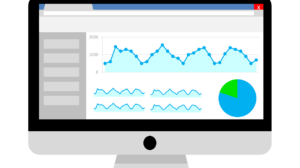Great visuals are one of the most important elements of successful social media posts, with 74% of social media marketers using visual assets. Traditional graphic design tools can be a little daunting to use, though. Not to mention they’re expensive—a small agency or freelancer might not have the funds to drop on Photoshop.
These free, web-based graphic design tools aim to solve those problems. With a focus on usability and accessibility, they’ll have you designing professional graphics in no time.
1. Canva
You’ve probably heard of the popular design app Canva. It’s an easy-to-use web app that let’s you create almost any media you need—social media graphics, marketing materials, invitations, and more. Canva is free to use, but you can upgrade to Canva for Work to unlock additional features, if you want.
Everything works via drag-and-drop selection, and the whole app is designed to be as user-friendly as possible. You don’t need any prior graphic design experience to create gorgeous visuals with Canva.
2. Gravit Designer
Gravit Designer is a free and fully featured vector design app. Vector art is created using mathematical equations and can be scaled infinitely without distorting, making it perfect for logos, icons, and anything else that might be used at multiple sizes. Gravit offers a wide range of tools that rival some of the top offerings from Adobe, like Illustrator.
Gravit Designer’s layout and controls are fairly standard for this type of program. Each project has pages and layers that you can add objects to, like images, text, shapes, and more. You can then manipulate these objects with various tools, brushes, and effects. When you’re done, you can export your project in a variety of formats. The app works very well, especially considering it’s free and works cross-platform.
3. Sumo Paint
Sumo Paint is a free photo and image editor. While it probably won’t replace Photoshop for the professional photographer, it offers more than enough power for touching up images and photos for social media posts. Sumo Paint requires Adobe Flash Player, so make sure you have that installed.
Sumo has the usual blur, gradient, smudge, and line tools common to photo editors, as well as its own set of custom tools including kaleidoscope and liquid wave. The various effects are easy to use, and the interface is simple to navigate—which is refreshing in a genre of software where things can feel as complicated as humanly possible.
4. Google Charts
Charts and graphs are a great way to keep track of (and show off) key metrics for your campaigns. And if you need charts, you need Google Charts. This web app from Google makes creating gorgeous charts and graphs simple, and the ability to connect your data and update the chart in real time is incredibly useful.
Using Google Charts is easy. Pick a template and design your chart, and the tool provides you with code to make your chart a reality. There are step-by-step tutorials complete with images if you need help. It might take a few minutes to get your bearings if you’ve never seen or worked with HTML or JavaScript, but you’ll get the hang of it quickly. Hey, if Google uses it, it must be good.
5. Easel.ly
Ever see a great infographic and wonder how the poster created it? Hint—it isn’t magic. It’s probably a tool like Easel.ly. Easel.ly makes creating infographics a snap. The app provides numerous free templates, and you can upgrade to a pro account if you need more.
Once you select your template, you can choose from a huge library of fonts, text styles, arrows, and connector lines to make your infographic awesome. And you should. Infographics have been shown to outperform blog posts in certain circumstances. This is one type of content you don’t want to ignore.
Do I Need Anything Special to Use These Tools?
These tools are designed to be easy for anyone to use, so you don’t need a background in graphic design to get started. A few things can make the experience better, though:
- Your browser. The browser you choose can have a big impact on the performance of web apps. Google’s Chrome is widely regarded as the best browser around, and many web apps are optimized for it. If you’re not a Google fan, though, Firefox is still great.
- Your internet connection. You don’t need anything incredibly fast, but a good speed will certainly help. Having a reliable connection that’s available everywhere is probably most important for working online.
- Your monitor. The display you use is important—not only for your eyesight but also for color accuracy. You don’t want something to look blue on your screen and be green on everyone else’s. A high resolution can also help keep things clear as you work on the tiny details of your project.
Graphic design can be tough if you’re not a pro, and the tools can be expensive, but these five apps aim to solve those problems. What are you waiting for? Check them out today.





